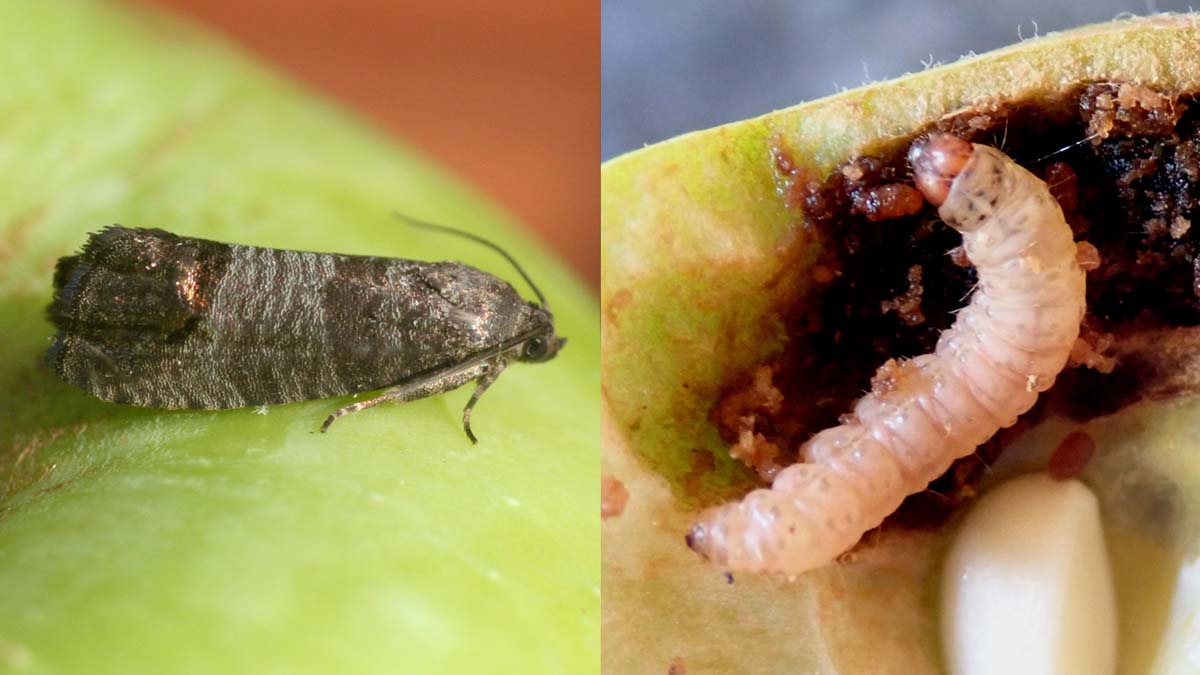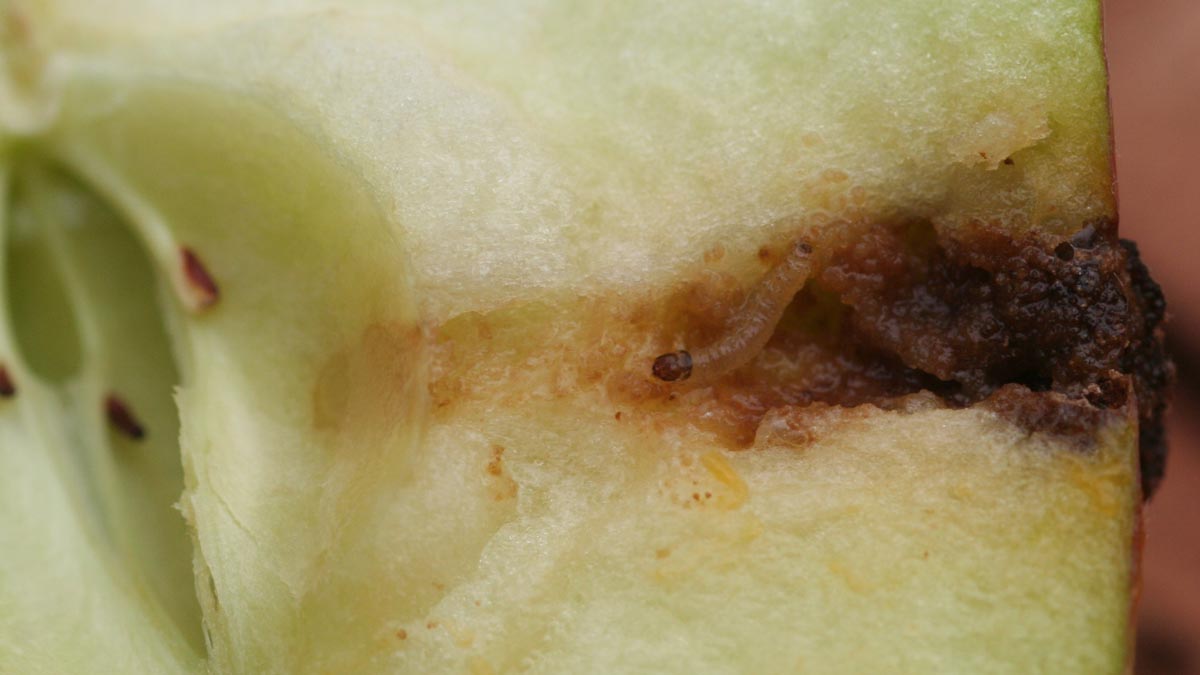Codling Moths
Pest Common Name
- Codling Moth (Cydia pomonella)
- Apple
- Pear
- Quince
- Less frequently, hawthorn, apricot, plum, English walnut
Codling moth adults are 1/2-3/4 inch long. The wings are held tent-like over the body, are mostly mottled grey, and the wing tips have a coppery-brown band. Larvae are 1/10 (2-3 mm) - 3/4 (12-20 mm) inch long, white to light pink with a dark brown head capsule (Figure 1).

Biology
The development and activity of the codling moth is temperature related. They overwinter in leaf litter, bark crevices and other protected locations as mature larvae in a cocoon. The larvae pupate in early spring. Spring temperatures determine when the adults hatch from the pupae.
There are one to four generations of codling moth in different regions of Idaho. First-generation adult activity is limited by cooler evening temperatures. When evening and night temperatures fall below 50 degrees Fahrenheit adult moths are inactive. As evening and night temperatures rise above 60 degrees Fahrenheit egg laying activity increases.
Egg development is also temperature related. This temperature dependence is why spraying can’t just be based on blossom development or petal drop. Different cultivars have different bloom schedules, and every year is different.
Damage
Codling moth is the most damaging insect pest of apple and pear fruits. It is established in almost all apple growing regions of the world.
The eggs are laid on leaves, branches, spurs and fruit. Hatched larvae find the fruit, tunnel through the flesh and feed primarily on the seeds. The entry tunnels are small. Large tunnels are an indication of an exit tunnel — they are often the same tunnel.
If they destroy all the young seeds there may not be enough hormone produced by the seeds, causing fruit drop in mid-summer.
While the primary food for the codling moth larvae is the seed, the tunneling makes the fruit unmarketable and limits its utility for home processing (Figure 2).

Monitoring
Timing is critical for codling moth control. Pheromone traps are placed in trees before the over-wintering population hatches and begins laying eggs. Place traps by early-March in USDA Zone 7 areas, mid-March in USDA Zone 6 areas, and early-April in USDA Zones 4 and 5 areas. USDA Zone 3 and colder should have their traps in place by late April.
Management
Primary Management Tactics
There are codling moth degree-day models that are linked to various weather stations around Idaho. Once adults are caught in the pheromone trap, the model is applied to the temperatures in that region to determine when the eggs will first hatch. Applying control measures too soon will be a waste of time and insecticide. Too late may mean missing the first big flush of codling moth larvae.
Physical
- Apple bags are effective if applied when the fruit is dime to quarter-sized. The biggest drawback is the time it takes, but you only do it once. Brown lunch bags, cotton string bags and nylon footies can be used. The nylon footies are not as effective but improve when they are pre-soaked in a kaolin clay solution. The footies will stay on better if tiny elastic bands are stretched over the fruit and nylon at the stem. Paper bags can be modified with a slit in the bottom of the bag through which to slip the small fruit and staple the top shut. Windy areas, such as south-central and eastern Idaho may require a little modification to keep the bags on the fruit during spring winds. Fruit can be treated before bagging with one insecticide or horticultural oil spray. Paper and cotton string bags should be removed a week or two before the fruit is harvested so that it will develop its color. This may expose them to end-of-season codling moth damage.
Cultural
- Sanitation — remove and destroy any fruit on the ground or fruit in the trees that shows signs of insect feeding beginning about eight weeks after petal drop
- Codling moth larvae will often enter the fruit where fruits touch each other
- Apples and pears should be thinned early in the season when the fruits are a dime to quarter in size
- There should not be more than one apple per blossom cluster and the trees should be further thinned so that there is about six inches between fruits
Biological
- While there are several predatory and parasitoid insects that feed on codling moth, biological controls are not generally effective on backyard trees
- Mating disruption may be part of an integrated approach in commercial orchards
Chemical
- Timing is critical.
- If you want good control, the first spray should be timed to occur just before the eggs hatch. This is best done by trapping first generation adults and following a degree-day model for weather in your area. The first trapped adults indicate when they are flying, mating and laying eggs.
- For those who are okay with a little damage, sprays can be applied a little bit later to cover the peak egg hatch. If this technique is used sanitation is very important. Early strikes should be removed and destroyed or composted.
- As most regions of Idaho have multiple generations of codling moth, it is important to apply control measures that will be effective throughout the growing season until about Sept. 15, when codling moths become inactive due to day length
- The frequency of sprays depends on the longevity of the product
- In areas with multiple generations, use a different product for each generation to reduce the chance of developing a resistant population. There is usually about a week between the first and second generation, and maybe a day between second and third generation. From that point the generations overlap.
- Select insecticides that will be less damaging to beneficial insects and spiders. Application of broad-spectrum insecticides may result in a secondary pest flareup, such as spider mites in mid-summer.
- Recommendations for pesticides to use in the management of codling moth can be found on the PNW Pest Management Handbooks website
Pesticide Warning
Always read and follow the instructions printed on the pesticide label. The pesticide recommendations in this University of Idaho webpage do not substitute for instructions on the label. Pesticide laws and labels change frequently and may have changed since this publication was written. Some pesticides may have been withdrawn or had certain uses prohibited. Use pesticides with care. Do not use a pesticide unless the specific plant, animal or other application site is specifically listed on the label. Store pesticides in their original containers and keep them out of the reach of children, pets and livestock.
Trade Names — To simplify information, trade names have been used. No endorsement of named products is intended nor is criticism implied of similar products not mentioned.
Groundwater — To protect groundwater, when there is a choice of pesticides, the applicator should use the product least likely to leach.
- Figures 1-2. Whitney Cranshaw, Colorado State University, Bugwood.org








